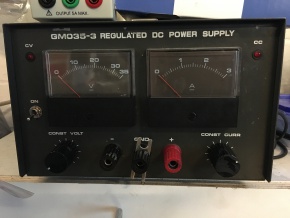Electronics/GM035-3: Difference between revisions
No edit summary |
m add category |
||
| (One intermediate revision by one other user not shown) | |||
| Line 1: | Line 1: | ||
[[Category:Tools_and_Equipment]] | |||
[[Category:Electronics]] | |||
{{Equipment | {{Equipment | ||
| title = GM035-3 Power Supply | | title = GM035-3 Power Supply | ||
| Line 18: | Line 20: | ||
It's very heavy and bulky because it is a linear power supply containing a large transformer and three high-power heatsunk transistors. It does not use a fan, so under high load (particularly short circuit) it can get fairly warm. | It's very heavy and bulky because it is a linear power supply containing a large transformer and three high-power heatsunk transistors. It does not use a fan, so under high load (particularly short circuit) it can get fairly warm. | ||
The voltage set pot seems to be a bit problematic and the voltage can drift by half a volt - this might be sorted by cleaning the pot or replacing it. In the meantime, if you need a more precise output voltage you should use one of the other units. The current adjustment is not affected. | |||
== Safety == | == Safety == | ||
Latest revision as of 11:09, 19 June 2017
 | |
| Heavy lab power supply | |
| Equipment Information | |
|---|---|
| Status | Unknown |
| Manufacturer | Tagasaki |
| Model | GM035-3 |
| Hackspace Information | |
| Induction Required | Yes |
| Induction Information | Here |
| Card RFID Enabled | No |
| Owner | Tom (Permanent Loan) |
The Basics
A very useful unit which can output anywhere from 0-35 volts DC at 0-3 amps.
This power supply has a CC/CV mode which means it is safe to short the output. If the output is shorted, it will limit the current to the set point and drop the output voltage to nearly zero. Shorting may produce sparks as the output capacitor is discharged and this may wear down connectors so try to avoid doing this. You can think of it as a two-quadrant supply; it will always keep the voltage OR current limited, according to the lower of the two limits.
It's very heavy and bulky because it is a linear power supply containing a large transformer and three high-power heatsunk transistors. It does not use a fan, so under high load (particularly short circuit) it can get fairly warm.
The voltage set pot seems to be a bit problematic and the voltage can drift by half a volt - this might be sorted by cleaning the pot or replacing it. In the meantime, if you need a more precise output voltage you should use one of the other units. The current adjustment is not affected.
Safety
You must read the safety documentation in this link before using this equipment.
The maximum output of the power supply of around 36 volts is below the SELV limit. This means it is *generally* safe to touch. However, it is still possible to pass a dangerous amount of current through your body using this unit, for example through open sores. The current is also sufficient to cause burns if you are careless.
The output current is more than sufficient to release smoke from devices and wires, which could be a fire hazard. You should ensure you always set an appropriate current limit.
Uses
The CC mode can also be used to power high-power LEDs without use of a resistor. Simply set the current limit to the rating of the LED. To read and set the current limit, set the voltage to zero, short the output of the power supply, increase the voltage dial until the "CC" LED illuminates then adjust current until the desired limit is reached.
Another use for the CC mode is to "bring up" a project slowly to avoid smoke release. Set the voltage to the desired limit, but before connecting your load, set the current to zero. Connect your load, then slowly increase the current. If all is well, the voltage will rise with the current increase and the load will work. If there's a problem, voltage will stay low but current will continue increasing. If you see this, you can disconnect the load before damage occurs.
Mains switch wear
The mains switch has been replaced twice on this unit. The high inrush current of the power supply wears out the switch and it becomes intermittent. Therefore, avoid cycling the switch to turn your load on and off (instead, simply set voltage to zero) and try removing the load before turning power off.
Induction
Ask on the mailing list for volunteers to demonstrate the use of any of the test equipment.